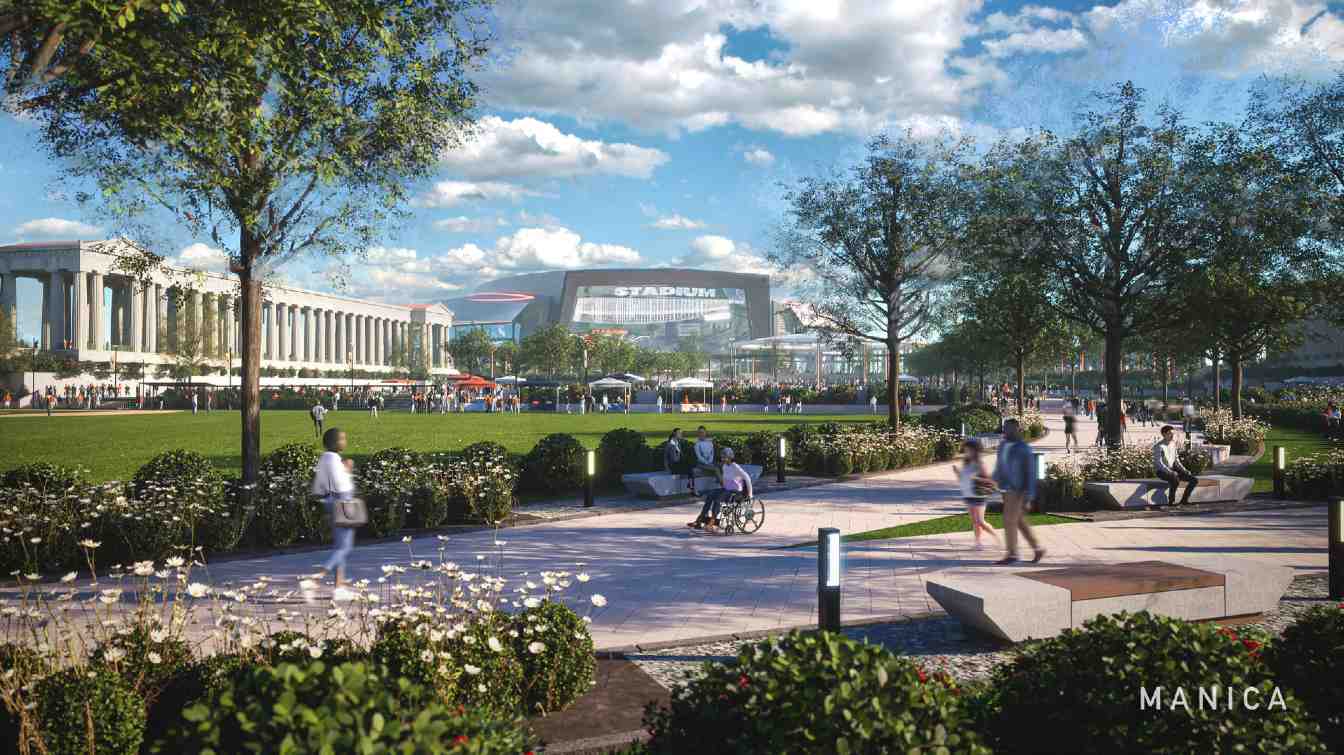USA: Stadium and glass? Spectacular project along Lake Michigan
source: StadiumDB.com; author: Jakub Ducki
 US studio Manica Architecture and NFL team Chicago Bears have presented a proposal for a redeveloped football stadium in the state’s biggest city, but before it can be restructured, a plan has to be presented that calls for a replacement stadium some 7 miles away from Soldier Field along the lake coastline.
US studio Manica Architecture and NFL team Chicago Bears have presented a proposal for a redeveloped football stadium in the state’s biggest city, but before it can be restructured, a plan has to be presented that calls for a replacement stadium some 7 miles away from Soldier Field along the lake coastline.
Advertisement
Replacement stadium. A second 60,000-seater?
First, a location had to be found for a replacement arena, which became Burnham Park, chosen as the best for the city, the state and the Chicago Bears. It provides the most benefits for all sides. The second option rejected was the Michael Reese site, which proved to be too narrow to accommodate the development.
The number of people who will be able to watch a Chicago Bears game there will stand at a similar level to Soldier Field, with the addition of standing room. The estimated number of fans at the local American football club's games will exceed 65,000, yet the facility is intended to appear intimate. According to the designers, this is becoming a trend in contrast to larger venues with poor seating away from the pitch.
The project should begin in the summer of 2025. It will take exactly three years from the time the shovel is put into the ground until the first fans enter the stadium. There is an urgency for interested parties to start construction on time, as each passing year increases costs by around $200 million.
Stadium of Chicago will replace the home of the city's football team for the redevelopment and will include more open, green space than is currently available, with year-round free and accessible squares, pathways and planted green areas. The new stadium will remain in public ownership and will give Chicago residents the use of around 5.5 hectares of athletic fields, becoming public property of the city in the future, for which the Chicago Bears will sell the naming rights to the new arena.
The stadium will be able to be used for everything from concerts to high-profile sports games and community events. It has the potential to unlock new revenue streams for the city and state. It is estimated that the operation of the new arena will yield a 41% increase in annual Illinois tax revenue from current operations compared to the current one at Soldier Field.
Soldier Field redevelopment
It doesn't end there though - it's time for the most important item on the list of stadium plans in Chicago. The new venue to be built on the site of Soldier Field and associated improvements will add up to one of the largest construction projects in Illinois history, bringing in $4.7bn in direct capital investment and creating some 43,000 jobs for the regional workforce.
Manica Architecture designed the stadium-enclosed by a semi-transparent roof - to bring a variety of concerts, community celebrations and sporting events to downtown Chicago. As with the studio's other project - Allegiant Stadium for the Las Vegas Raiders - visuals show an elongated stadium with a bubbling glass roof. The arena will be surrounded by planted green space and pedestrian access will be provided. The facility will be connected to the adjacent marina and public transport station.
The new Soldier Field would be capable of hosting major sporting events year-round, including the Super Bowl and NCAA Final Four, as well as major global entertainment events, which would generate billions of dollars in profit.
Where will the money for such a large investment come from?
It is estimated that the new stadium will cost $3.2bn, with more than 72% of the project to be funded by the Chicago Bears and NFL investment of around $2.3bn. To fill the $900m funding gap, the Chicago Bears are working with the Illinois Sports Facilities Authority (ISFA) to extend the bond for 40 years.
The construction of this project will make Illinois more prosperous. An economic impact study found that it will provide 24,000 new jobs for Chicago residents and 43,000 in the greater region, bringing $2.4bn in job income to the city and $3.5bn to the state of Illinois. Once operational, the stadium is projected to create 2,300 permanent jobs per year in Chicago, generating $92 million in job income for the city. The development of the stadium is projected to have more than $8bn in direct and indirect business impact on the economy, so it can be argued that the new home of the Chicago Bears will drive the state's economy.
In addition, an infrastructure plan has also been created, which has been divided into three phases. Phase 1 will cover stadium opening requirements, transportation, roads and utilities. It will amount to $325m. Phase 2 would cost $510m and would include the expansion of the bus depot, new parks and playing fields. Phase 3 has been priced at $665m and would include additional transport improvements, retail and public attractions. In total, the infrastructure plan will cost around $1.5bn.
Advertisement
 StadiumDB
StadiumDB ©
©  ©
©  ©
©